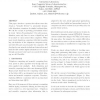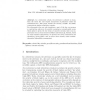446 search results - page 5 / 90 » Who's Got the Key |
JUCS
2006
13 years 7 months ago
2006
: Bisimulation can be defined in a simple way using coinductive methods, and has rather pleasant properties. Ready similarity was proposed by Meyer et al. as a way to weakening the...
SIGMOD
2004
ACM
14 years 7 months ago
2004
ACM
Secure communication guaranteeing reliability, authenticity, and privacy in sensor networks with active adversaries is a challenging research problem since asymmetric key cryptosy...
ISWC
2000
IEEE
13 years 11 months ago
2000
IEEE
This paper describes a system that allows users who obtain a “wearable ID key” to personalize dynamically ubiquitous computers by simply touching them. We call the concept of ...
ASPDAC
2004
ACM
13 years 10 months ago
2004
ACM
In the well-known "prisoners' problem", a representative example of steganography, two persons attempt to communicate covertly without alerting the warden. One appr...
FSE
2004
Springer
14 years 11 days ago
2004
Springer
Abstract. In a related-key attack, the adversary is allowed to transform the secret key and request encryptions of plaintexts under the transformed key. This paper studies the secu...


